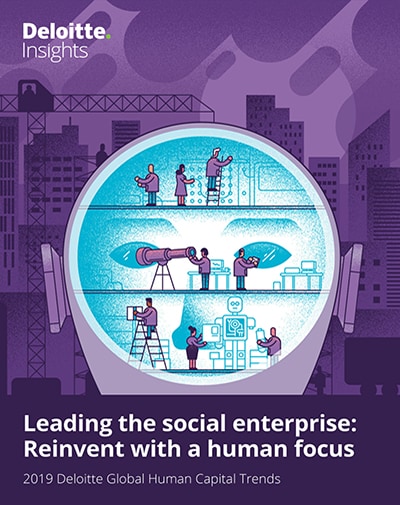
The alternative workforce: It's now mainstream 2019 Global Human Capital Trends
8 minute read
11 April 2019
The alternative workforce can be a long-term solution to tight talent markets—but only if treated strategically.
For many years, people viewed contract, freelance, and gig employment as “alternative work,” options considered supplementary to full-time jobs. Today, this segment of the workforce has gone mainstream, and it needs to be managed strategically. Given growing skills shortages and the low birth rate in many countries, leveraging and managing “alternative” workforces will become essential to business growth in the years ahead.
Learn more
Watch the related video for this trend
View 2019 Global Human Capital Trends
Download the Deloitte Insights and Dow Jones app
Download the full report or create a custom PDF
Deloitte’s 10th annual Global Human Capital Trends Report is coming soon. Get it first by signing up!
Originally conceived of as contract work, “alternative” work today includes work performed by outsourced teams, contractors, freelancers, gig workers (paid for tasks), and the crowd (outsourced networks). The world is seeing rapid growth in the number of people working under such arrangements. By 2020, for instance, the number of self-employed workers in the United States is projected to triple to 42 million people.1 Freelancers are the fastest-growing labor group in the European Union, with their number doubling between 2000 and 2014; growth in freelancing has been faster than overall employment growth in the United Kingdom, France, and the Netherlands.2 And many people are alternative workers part-time: Deloitte’s latest millennial study found that 64 percent of full-time workers want to do “side hustles” to make extra money.3
For organizations that want to grow and access critical skills, managing alternative forms of employment has become critical. Many countries are seeing declining birth rates,4 reducing the size of the labor pool. Forty-five percent of surveyed employers worldwide say they are having trouble filling open positions, the largest such percentage since 2006. Among companies with more than 250 employees, the percentage struggling to find qualified candidates rises to 67 percent.5
Alternative work comes in many shapes and sizes
- Alternative workforce: Includes contractors, freelance/independent workers, gig, and crowd workers.
- Freelance/independent workers: Workers who extend the core employee workforce and are typically paid by the hour, day, or other unit of time.
- Gig workers: Workers paid by the task (or microtask) to complete a specified piece of work.
- Crowd workers: Workers who compete to participate in a project and are often only paid if they are among the top participants in a competition.
At the same time, retirees are reentering the workforce, people are spending time caring for children and aging parents, and individuals are going back to school. These trends create more depth and scale across the range of alternative talent pools.6
The breadth of the alternative workforce
Once considered a workforce for information technology (IT) or other technical or repeatable tasks, today alternative workers perform a broad range of activities. In this year’s Global Human Capital Trends study, 33 percent of respondents reported extensively using alternative arrangements for IT, 25 percent for operations, 15 percent for marketing, and 15 percent for research and development (figure 1). One of our pharmaceutical clients outsources all of its research, for example; others outsource product design, development, and support.

If we look at this market around the world, we find many sources for these workers. Traditional contingent staffing firms, such as Allegis and others, make up the core of the market, but new talent networks (such as UpWork, Fiverr, 99designs, and more) are growing quickly. We are even starting to see talent networks focused on specific segments of the workforce ranging from working parents to active military and veterans (The Mom Project, The Second Shift, WeGoLook, and more). Research shows that these types of talent networks now manage over US$2 billion in outsourced activity,7 employing hundreds of millions of people in every geography of the world.
A major acquisition underscores the alternative workforce’s increasing economic importance. In 2017, Google acquired Kaggle, one of the world’s largest networks of data science professionals.8 As one of the world’s biggest technical communities, Kaggle’s attractiveness to organizations seeking freelance or contract-based technical talent has enormous potential for growth. Platforms and talent marketplaces like Kaggle—and their prospects for generating tangible returns—are evidence of the potential and value offered by alternative workforce strategies.
Most organizations are using alternative workers transactionally, not strategically
How fully are organizations capitalizing on the alternative workforce today? Our survey results suggest that many could be doing more. Forty-one percent of our survey respondents told us they considered this issue important or very important—but only 28 percent believe they are ready or very ready to address it. In fact, our research suggests that most organizations look at alternative work arrangements as a transactional solution, not as a strategically important source of talent. Only 8 percent of our respondents, for instance, said that they had established processes to manage and develop alternative workforce sources (figure 2); fully 54 percent of respondents said they either managed alternative workers inconsistently or had few or no processes for managing them at all. These organizations are using alternative work tactically as a way to “fill slots,” not strategically as a long-term solution for the future.

What’s more, our 2019 survey showed that using alternative workers can enhance organizational performance (figure 3). This is the real reason that managing alternative work and workers well is strategically important: It enables an organization to put the right talent in place where and when it’s most needed to get results, in a labor market where traditionally on-balance-sheet talent is becoming ever harder to find.

For instance, the German company Robert Bosch GmbH has created an entire subsidiary—Bosch Management Support GmbH—to manage its on-call contingent workforce of more than 1,700 former and retired Bosch employees worldwide. These “senior experts” are brought in to consult and work on projects at Bosch on an as-needed basis, often at short notice, in functions as varied as research and development, production, purchasing, finance, and sales and marketing. Bosch claims a 92 percent satisfaction rate among these workers’ customers, who value them both for the work they perform and for the coaching and development opportunities they bring to younger Bosch associates.9
Rewiring the approach to the alternative workforce
Engaging alternative workers strategically is harder than it looks. To do so, companies have to move beyond “managing” contractors and freelancers to “optimizing” and “leveraging” the alternative workforce deliberately and well. Not many do. Even among companies with policies and standards, our experience suggests that a strategic, enterprisewide approach is rare. What is needed is a wholesale rewiring of how organizations operate as it relates to alternative labor—one that allows it to connect the appropriate talent with the appropriate roles no matter how that talent is sourced. Part of the answer lies in connecting the various parts of the enterprise involved, often in a fragmented manner, in hiring alternative workers. This includes procurement, IT, and, increasingly, HR.
The good news is that, at many organizations, HR is indeed stepping up in this area. Seventy-five percent of this year’s survey respondents indicated that HR supports sourcing alternative workers; 66 percent reported HR is involved in training them, 65 percent said HR negotiates work arrangements, and 63 percent reported HR is involved in benefits management. And investments to expand HR strategies to the alternative workforce are also rising. More than half of our respondents (51 percent) reported that their organization has specific plans to address recruitment strategies for the alternative workforce. Further, 31 percent of respondents now have learning and development plans for alternative workers, 23 percent survey them for feedback, and 22 percent award them bonuses and other types of incentive pay.
A parallel step for organizations to consider is to take advantage of the growing portfolio of alternative workforce management tools that are coming on the market. In 2018, Workday acquired Rallyteam, a gig work platform,10 and ADP acquired WorkMarket, a leading contingent and gig work platform.11 ADP had previously acquired a company called Global Cash Card to provide real-time pay and cash-based pay solutions for gig workers.12 SAP acquired FieldGlass with the same functionality goals.13 Vendors like Fuel50 now offer standalone company career and gig work platforms.14 And Legion, a startup in the San Francisco area, is building an entire workforce management platform under the assumption that some people will always work for multiple employers at once.15 These alternative workforce management tools are designed to fill a gap in the market and enable new connections among those managing various workforce segments and types, thereby finally enabling a total workforce view.
Alternative workers, mainstream respect
Remembering our principles for human capital reinvention, businesses must consider issues of inclusion, diversity, fairness, and trust when constructing organizational systems around alternative work. Alternative workers can have different backgrounds and cultures than many traditional workers, and these individuals are often accessed in different ways. Can managers lead a team with a diverse mix of people from both traditional and alternative talent pools, when each may come to work with a different set of motivations? Can the organization engage the alternative workforce in a way that promotes the organization’s brand as a social enterprise?
It’s important that the entire workforce, both alternative and traditional, be treated with respect with regard to culture, inclusion, and work assignments—and that perceptions on all sides reflect these values. While the greater risk is arguably that alternative workers will feel they are treated as outsiders—thus potentially damaging an organization’s overall employment brand—it’s also possible for the knife to cut the other way. At one major European bank, for example, as part of a movement to create more flexible access to talent in various technology-related fields, managers in the IT department started working systematically with contractors, freelancers, and consultants. But over time, leaders realized that the function’s on-balance-sheet employees, who worked almost solely on legacy systems, felt “penalized” compared to these external workers, who were hired for more-interesting projects with “cool,” newer technologies. The bank’s IT leadership took steps to rebalance the mix—and the experience has now enabled the bank to more effectively access and use alternative labor pools in its IT function.16
Risks and challenges like these are not insurmountable, and the alternative workforce is now a critical mainstay of the workforce for a growing number of employers. Organizations that take this workforce seriously can build strategies and programs to access and engage talented people wherever they may sit in the labor pool, driving business growth and extending the diversity of the workforce.

© 2021. See Terms of Use for more information.
Explore the collection
-
Accessing talent Article6 years ago
-
Talent mobility Article6 years ago
-
Rewards Article6 years ago
-
HR cloud Article5 years ago
-
Looking ahead Article6 years ago
-
2019 Global Human Capital Trends Collection





















